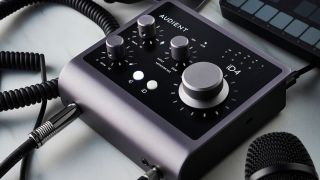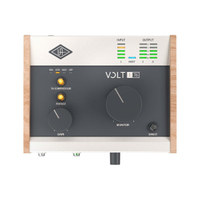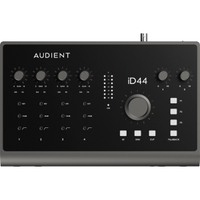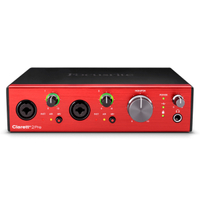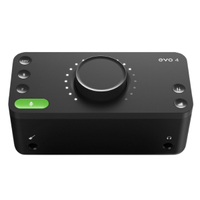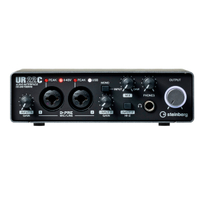If you want to record high-quality audio, one of the best audio interfaces is a studio essential. From musicians and podcasters to streamers and filmmakers, the availability of audio interfaces at reasonable prices has opened up huge opportunities for creatives, whether you're recording a full solo album at home or wanting to collaborate with friends on a podcast.
There's a huge number of audio interfaces on the market in 2024 which can make choosing difficult, and that's where we come in. Here at MusicRadar, we've tested countless models to compile this best audio interface guide. Our rigorous testing procedure encompasses everything from recording on the go with a smartphone to classic home studio recording in a permanent space.
For us, the very best of the bunch right now is the Focusrite Scarlett 2i2 4th Gen, which delivers the best combination of usability, performance, and affordability. For those on a tight budget, we'd recommend checking out the Behringer UMC22, which retails well below the $/£100 mark. If you want the best of the best, then our choice is the Universal Audio Apollo Twin X, which provides the ultimate in audio quality, but at a price.
Each of the products in this guide have been personally tested by the MusicRadar team to provide you with a real-world, unbiased recommendation. We've taken the extra step to list each interface by use case to make it easier for you to select the right one for your needs, so keep scrolling to find your perfect match.
Looking for an audio interface bargain? Explore hand-picked savings on gear we rate and stay updated with this year's best Prime Day music deals.
Our top picks

For us, it doesn't come much better than the Focusrite Scarlett 2i2. Its combination of excellent quality preamps, huge feature set, solid drivers, and excellent software bundle make it our top recommendation for anyone looking for a new audio interface.
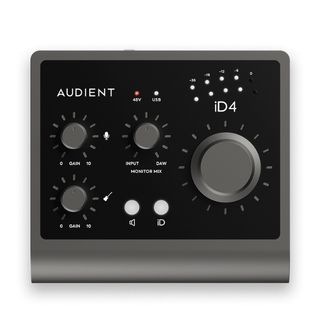
If you're getting into recording for the first time, it's good to have something easy to use, but also with features to grow into. The Audient iD4 MkII gives you exceptional quality preamps, an ultra-low noise floor, and loads of useful features all at a price that is phenomenal value for money.
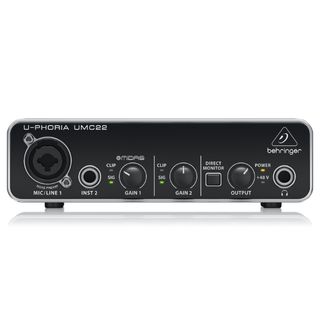
If money's tight or you'd rather spend that budget on a decent microphone, the Behringer U-Phoria UMC22 gives you a lot of bang for relatively little buck. The MIDAS preamps sound great and although there's no dedicated driver, at this price point it seems churlish to complain about anything really.
Recent updates
03/07/24: We've added more detail to our product descriptions, adding categories to make them easier to navigate. Star ratings have been introduced for each of these categories so you can get a more granular view on our opinions of critical features. An overall specs table has also been added for easy comparison between different interfaces in the guide.
11/06/24: We reviewed our choices and introduced a new 'best overall' category for the interface that our tests showed was the best option for every type of user, balancing features, performance and budget. We also added a new 'meet the experts' section to introduce you to some of our key testers and to outline their credentials. We also expanded sections of our buying advice.
Best overall
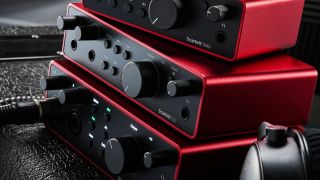
✅ Buy if you want an easy-to-use interface with loads of features: With its small size but top-quality preamp and huge feature set, the Scarlett 2i2 is the perfect companion for recording instruments at home.
❌ Avoid if you don't like software: For some features, the 2i2 relies on the Focusrite Control app, which can be annoying for users who prefer button controls.
🎛️ The Focusrite Scarlett 2i2 4th Gen is one of the most popular audio interfaces ever made for good reason. Feature-packed with transparent preamps, it's a master of all trades.
Overview: With its compact size, low price point, and powerful functionality the Focusrite Scarlett 2i2 4th Gen is perfect for those looking to set up a home studio. Whether you’re recording your guitar at home, using it as a mobile recording rig, or for live shows, this brilliant bit of kit will provide excellent recording quality.
Features: The huge array of features on the Scarlett 4th Gen interfaces makes them incredibly user-friendly. Auto gain adjusts automatically to the strength of your input signal, while clip safe prevents you from pushing the signal into distortion, both of which are excellent tools for beginners. We love the sound of the 'Air' preamp emulation which adds a touch of high end to the signal, and you can press again to add a little saturation too.
Software: Focusrites driver delivers ultra-reliable performance on both Windows and Mac, but if you're on the latter you can go one step further with ‘codeless kernel extension’. This allows you to drop your latency to below the 5ms mark which is a frankly incredible number. It requires a fiddly installation, but for us, it’s totally worth it if you’re going to be using synth plugins in a live scenario.
Performance: The latest iteration of Focusrite audio interfaces delivers fantastic performance for the recording musician, whether you want to plug your guitar in the front or your vocal mic in the back. The huge gain range from the preamps means it can handle a wide variety of applications too, from the quietest vocal to the loudest snare drum.
Read the full Focusrite Scarlett 2i2 4th Gen review
| Test | Results | Score |
|---|---|---|
| Connectivity | Excellent, no MIDI | ★★★★☆ |
| Features | Auto gain, clip safe | ★★★★★ |
| Software | Generous software bundle | ★★★★★ |
| Performance | Fantastic performance | ★★★★★ |
Best for beginners
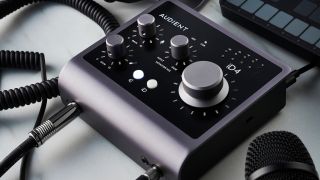
✅ Buy if you want your first audio interface: Combining excellent value for money with an easy-to-use interface and plenty of pro-level features, the Audient iD4 is the perfect choice for first-time recording artists.
❌ Avoid if you need MIDI: There are no MIDI connections here so one to avoid if you need to integrate MIDI control into your setup.
🎛️ The Audient iD4 MkII is perfect for beginners, combining high-quality preamps with easy usability. Despite the relatively low cost, it's packing premium-grade components to deliver quality recordings.
Overview: Arguably the best audio interface under $200, The iD4 MkII is a simple two-input/two-output offering featuring a mic preamp, complete with phantom power for using condenser mics. The simple control scheme makes it great for beginners, but there's plenty of deeper functionality once you've outgrown that phase.
Features: The whole thing is powered via USB-C and, with Apple’s camera connection kit, it can also work with an iPhone/iPad. However, for us, the studio devilry is in the details. Audient has really thought about everything with value and usability in mind, making what is a budget solution feel anything but inexpensive in use.
Software: In keeping with its beginner-friendly ethos, the Audient iD4 is nice and easy to install, with a robust driver on Windows. It also features one of the most complete software offerings of any of the interfaces here, with Cubase LE3, Sonarworks, Strymon BigSky reverb plugin, Two Notes Torpedo Wall of Sound Speaker Emulator, and even 3 free online courses from Produce Like A Pro.
Performance: We love the JFET instrument input for plugging in your electric guitar or bass, which delivers similar characteristics to the input of a tube amp. It provides an excellent base tone for using guitar VSTs, great for guitar players looking to get into recording for the first time. The mic preamp features a healthy 58dB of gain, plenty for quieter dynamic microphones should you be recording vocals or other traditional instruments.
The smart scroll wheel enables you to tweak settings in your software which is a nice touch and we're big fans of the dual studio headphone outputs, which makes it great for recording band members or collaborating with other musicians. The design is extremely well thought-out, which is another tick in the box that makes the iD4 so beginner-friendly.
Read our full Audient iD4 MkII review
| Test | Results | Score |
|---|---|---|
| Connectivity | Needs USB 3.0, no MIDI | ★★★★☆ |
| Features | JFET input, works with iPhone/iPad | ★★★★★ |
| Software | Generous software bundle | ★★★★★ |
| Performance | Fantastic performance | ★★★★★ |
Best budget option
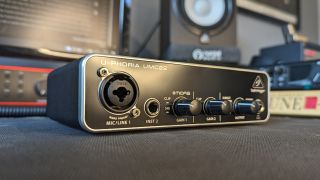
✅ Buy if your budget is tight: Costing well below the $100/£100 mark, this is the perfect audio interface for those with cost at the forefront of their needs.
❌ Avoid if you prefer a dedicated driver: To keep costs down there's no dedicated driver support with this interface, meaning you'll need to rely on third-party software like ASIO4ALL.
🎛️ The Behringer UMC22 is unbelievably cheap. Despite this, it still manages to do a fantastic job at the majority of tasks most musicians will ask of an audio interface, perfect for the budget-conscious out there.
Overview: Considering the price of the Behringer U-Phoria UMC22, it’s hard to find anything to fault. Of course, while there are better quality preamps or those with more connectivity and features on this list, if you’re after the best budget audio interface it doesn't come much better - or much cheaper - than this.
Features: The MIDAS preamp delivers excellent quality for recording vocals and guitars, and although it doesn't quite deliver the standards of others in terms of the noise floor, for anyone other than a pro engineer it's totally usable. It’ll do a fantastic job for those demoing songs at home or wanting to get simple recordings for various purposes, giving you everything you need with no extra fluff.
Software: One thing that does let it down is the lack of a dedicated Windows driver, so you’ll need to grab a 3rd party driver (ASIO4ALL is our choice) via Google search to get the best out of it. Doing it this way also means you may only be able to get sound out of one source depending on your setup, which could be limiting for some users. These are small issues, and considering it costs less than your average overdrive pedal, it’s hard to knock what you get for your money here.
Performance: We used it at home and on the road, finding the performance to be equal to any other interface at the beginner/budget level. It doesn't have all the shiny bells and whistles that others can boast, but the feature set covers the bases, including phantom power, a headphone output, and dedicated gain knobs for each input.
Read our full Behringer UMC22 review
| Test | Results | Score |
|---|---|---|
| Connectivity | Bare minimum | ★★★☆☆ |
| Features | Does the job | ★★★★☆ |
| Software | No additional software | ★★★☆☆ |
| Performance | Excellent performance for the money | ★★★★☆ |
Best for Mac
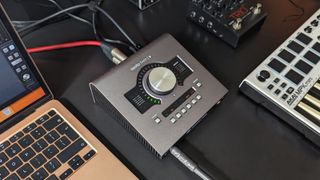
✅ Buy if you want the best audio interface for Mac: A UA interface and a Mac or Macbook are a tried and tested combination in the world of sound recording, whether you're a pro engineer or just making music at home.
❌ Avoid if you're on a tight budget: The UA Apollo Twin X isn't cheap and doesn't even include a Thunderbolt cable, making it a tough ask for those on a small budget.
🎛️ The Universal Audio Apollo Twin X is one of the best-quality audio interfaces available at the home recording level. Its DSP power ensures minimal latency and its Thunderbolt-powered integration into the Mac ecosystem delivers unreal performance.
Overall: We're big fans of the Universal Audio Apollo Twin X here at MusicRadar, and this super interface has some incredibly powerful features that will offer a serious upgrade to anyone’s home recording experience. It comes in two formats, Duo and Quad which are named for the amount of DSP processing chips they possess.
Features: There are two hybrid XLR/jack inputs on the back with an instrument input on the front that overrides one of the back connections. This isn’t too different from any other desktop-based interface here, however, the clever bit is how the Unison preamps are matched with DSP processing. This means you can load in a vintage Neve channel strip which will modify the behavior of the analog input for some uncanny recreations of 'proper' recording studio channels.
Software: You get a great selection of UA software included with the interface, including the legendary LA-2A and 1176 compressor plugins, Pulteq EQ plugin, and amp modellers in the form of Marshall Plexi for guitars and Ampeg SVT for bass. It's a very complete offering that will get you up and running if you've not built up your plugin collection yet, and you'll also get seamless integration with UA's Luna DAW.
Performance: The front face of the Apollo Twin X features a huge knob that can be used for volume control of studio monitors, headphones, and input gain, as well as some handy buttons for phantom power, muting, and various other features. We found it to be an incredibly fleshed-out and powerful recording experience using one of these and combined with the portable size, it’s the perfect interface for taking to and from recording sessions, with the connectivity to grow with you should you choose to invest further in the UA ecosystem.
Read our full Universal Audio Apollo Twin X review
| Test | Results | Score |
|---|---|---|
| Connectivity | Excellent, but no MIDI | ★★★★☆ |
| Features | Excellent range of features | ★★★★★ |
| Software | Powerful DSP software | ★★★★★ |
| Performance | Amongst the best | ★★★★★ |
Best for guitar
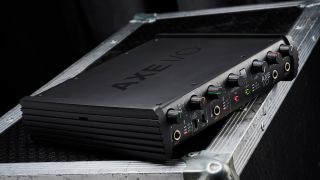
✅ Buy if you only want to record guitars: With loads of guitar-centric features, this is the perfect audio interface for recording high-quality electric and bass guitars.
❌ Avoid if you're not recording guitars: Of course, a guitar-specific interface probably isn't the best choice if you're using your interface for vocals or recording in the box.
🎛️ The IK Multimedia Axe I/O is the perfect companion for the recording guitarist. Packed with guitar-friendly features like a JFET input and super-easy reamping feature, it's one of very few guitarist-specific interfaces on the market today.
Overall: Most audio interfaces tend to be the jack-of-all-trades type, but with the IK Multimedia AXE I/O, you’re getting something that’s truly a complete guitar audio interface. Packed with useful features that will enable some sumptuous tones, it’s the perfect choice if you’re just going to be recording guitar.
Features: The dedicated JFET guitar input gives you loads of choices for sculpting your tones, from choosing between active and passive pickups to utilizing two types of preamp that allow you to get a pure clean tone or colour it with some extra harmonics. There’s also a ‘Z-Tone’ knob which allows you to adjust the impedance, giving you a brighter or darker tone depending on your preference.
Software: It wouldn't be complete without some great guitar software, and the Axe I/O delivers here too. It now ships with Amplitube 5 SE and Tonex SE, which is packed full of some of the best-sounding amp models we've ever heard. The intuitive software lets you control the interface without having to press any buttons, whether you want to adjust the sample rate, monitor volume, or just engage phantom power.
Performance: The handy ‘amp out’ output lets you feed a DI signal into a guitar amp or a pedal giving you an easy option to re-amp your tones without any external hardware. A ground lift switch lets you remove any unwanted hum, and it also features connectivity for external controllers, allowing you to use expression pedals or switchers with the included AmpliTube software.
For those recording guitars and guitars only, this is undoubtedly one of the best choices available.
Read our full IK Multimedia AXE I/O review
| Test | Results | Score |
|---|---|---|
| Connectivity | Good range of connections | ★★★★☆ |
| Features | Guitar orientated features | ★★★★☆ |
| Software | Comes with amp modellers | ★★★★☆ |
| Performance | Great for guitars | ★★★★☆ |
Best for streaming
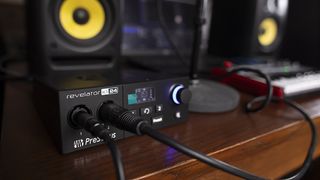
✅ Buy if you want to record audio for streaming: With its powerful Universal Control software, the PreSonus Revelator io24 is a great choice whether you're streaming your latest workflow tips or Call of Duty.
❌ Avoid if you like pressing buttons: With the majority of action happening within the software, those who prefer physical buttons may find this difficult to use.
🎛️ The PreSonus Revelator io24 is a brilliant option for streaming on a budget. Its powerful control software gives huge flexibility to bring various audio sources together to give your stream some professional sheen.
Overview: Whether you’re a musician or a gamer, live streaming is a big deal these days. Those looking for an audio interface for streaming might find some of the more regular options here a bit limiting, but the PreSonus Revelator io24 has been specifically designed to make this task a breeze.
Features: There are some great built-in DSP effects too, with plenty of presets to get you up and running if you’re not the type to mess with EQs and compressors. You can also use some of these as one-shot type effects thanks to the physical preset button on the unit, adding loads of reverb or delay to your voice for effect.
Software: The heart of the Revelator lies in its Universal Control software, which allows you to bring together multiple audio sources via loopback and route them to your streaming software of choice. You can bring audio in from various sources, whether that’s Discord, your DAW, or game audio, and give different monitor mixes to virtual collaborators.
Performance: It acts as a regular audio interface for making music too, so if you're a musician who wants to stream on a budget it's an excellent choice. We found the preamp quality to be really good for recording direct guitars and using microphones, making it an excellent all-rounder.
Read our full PreSonus Revelator io24 review
| Test | Results | Score |
|---|---|---|
| Connectivity | Excellent, with MIDI | ★★★★★ |
| Features | Works for streaming and regular recording | ★★★★☆ |
| Software | Powerful control software plus DAW | ★★★★☆ |
| Performance | Great performance | ★★★★☆ |
Best for vocals
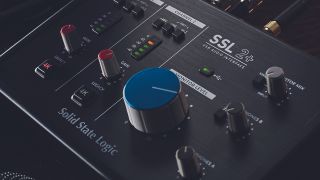
✅ Buy if you want the best audio interface for vocals: Boxing up that SSL sound into a compact interface, the SSL 2+ gives you phenomenal sounding preamps plus two headphone outs that make it great for working with vocalists.
❌ Avoid if you want a premium feel: As it's made out of plastic some would say the SSL 2+ feels a little cheap in places, especially the 4K button which admittedly feels a little flimsy.
🎛️ The SSL2+ is our choice for recording vocals at home. SSL preamps are world-renowned for their studio quality, and the SSL2+ delivers amongst the cleanest we've heard at the home recording level.
Overview: The SSL 2+ aims to bring affordability to that 'SSL' sound, packing pro features and connectivity into an audio interface that's within reach of the everyday musician. Taking their console designs from 7-figure recording studios, we love this interface for tracking vocals thanks to its excellent preamp quality and handy '4k' button.
Features: There are two combi mic/line inputs with Hi-Z (impedance) options for switching between guitar and bass signals or those from synths or drum machines, as well as MIDI connectivity should you need it. A +48v phantom power option also allows the connection of both condenser and dynamic mics. With great monitoring, recording quality, and connectivity the SSL 2+ comes highly recommended by us.
Software: The SSL2+ comes with a nice software offering, with plenty to help you start making full productions. Featuring BFD drums, Native Instruments synths, and Antares Auto-Tune for perfect vocal performances, it's a nice complement of tools for you to make great music. You'll also get three months of free access to SSL and Slate's Complete Access, which features over $12,000 worth of plugins to get your mix perfect.
Performance: It's a fairly standard 2-in, 2-out configuration that keeps things nice and simple for home users, and as always the SSL preamps deliver top-quality performance. We found little to no noise on the mic pres, even with the input gain cranked. The monitoring sound is fantastic too, delivering an up-front and honest tone that you'd normally find on much pricier interfaces.
The 4k button adds some extra presence and high-end zing, making your recordings feel a little bit more 'pro'. It's a subtle effect, it's not going to make anything leap out of the speakers at you, but nice to have in a pinch. More important for working with vocalists are the two headphone outs with dedicated volume knobs, allowing you to adjust the headphone mixes of both singer and engineer independently.
Read our full SSL 2+ review
| Test | Results | Score |
|---|---|---|
| Connectivity | Has MIDI and RCA connection | ★★★★★ |
| Features | Very complete feature set | ★★★★☆ |
| Software | Excellent software bundle | ★★★★★ |
| Performance | Fantastic performance | ★★★★★ |
Best for podcasting
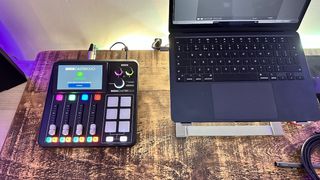
✅ Buy if you want the best audio interface for podcasting: Easy to use for the potentially less audio-savvy podcaster, yet packing enough depth to provide rewarding performance, the Rodecaster is perfect for getting a tip-top production out of your podcast.
❌ Avoid if you don't like software: You'll need to get to grips with some in-depth software to get the best out of this interface, so one to avoid if you don't like exploring on your computer.
🎛️ The Rode Rodecaster Duo is an amazing option if you're starting a podcast, or you want to add some more professional sheen to an existing one. The powerful software and quality preamps make it a breeze to get up and running, but there's plenty of depth on offer here too.
Overview: Podcasting is one of the fastest-growing forms of media right now, and if you want to start your own or upgrade one that’s already existing, the Rode Rodecaster Duo is our top choice.
Features: The size makes it easy to go live or start recording on the fly, as it won’t take up much precious desk space. This is handy if you’re playing multiple roles as a creative, or you’d prefer to record your podcasts on the go. Despite the small size, it’s still got plenty of features, with dedicated pads for sounds and faders for each channel.
Software: The software does take some learning if you’re used to using something different, but it's powerful and well worth the investment of time. Various 'Wizards' can guide you through this initial setup, great if you're new to podcasting, but there's a huge amount of depth on offer to tweak things to your liking if you're more experienced.
Performance: The mic preamps are fantastic too, with plenty of clean gain to drive podcasting microphones, even if you’re using the ever-popular and notoriously quiet SM7B. The noise floor is ultra-low, as you’d expect from a company that manufactures microphones. If you feel you need more mics for a bigger podcast, then the Rodecaster Pro II is also available with four inputs.
Read our full Rode Rodecaster Duo review
| Test | Results | Score |
|---|---|---|
| Connectivity | Good for podcasting | ★★★★☆ |
| Features | Great features for podcasts | ★★★★☆ |
| Software | Very powerful control software | ★★★★★ |
| Performance | Excellent preamps | ★★★★★ |
Best with MIDI
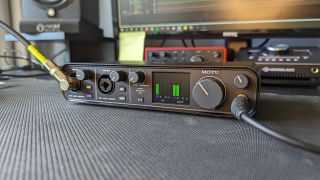
✅ Buy if you want a great audio interface with MIDI: With a huge variety of connection options, rugged metal enclosure, and DC-coupled outputs, the Motu M4 is a fantastic option whether you're recording in the studio or playing soft synths live.
❌ Avoid if you're on a budget: This feature-packed interface isn't the cheapest, so one to avoid if low cost is your number one requirement.
🎛️ The Motu M4 is an underrated audio interface that offers a lot of bang for your buck. Packed with features, connectivity, plus that awesome screen, if you're integrating synths or MIDI into a rig then this is the interface you should go for.
Overall: Whether you’re creating in the studio or performing live, the Motu M4 is undoubtedly one of the best interfaces to utilize with MIDI. It’s got fantastic preamps, four inputs for connecting multiple instruments, and an ultra-low latency performance.
Features: The full-colour LCD display is a fantastic addition for monitoring purposes, giving a surprisingly detailed view of your levels and certainly better than anything else we’ve tested. The latency figures are phenomenal too, and infinitely usable for real-time playing of virtual instruments.
Software: Motu's driver delivers some of the lowest latency performance we've ever encountered both on Windows and on Mac. The software bundle isn't as generous as some of the others here however. You do get Ableton Live Lite, 6GB of loops and sounds, and Motu Performer Lite which features a bunch of virtual instruments. Plenty to get you up and running if you don't have any software of your own.
Performance: With DC-coupled outputs and MIDI connectivity, the Motu M4 is a brilliant choice for anyone using hardware synths to make music. Having the ability to interface external synths via your DAW at this price point will be music to the ears of anyone using Eurorack or desktop synths.
Each channel has an individual button for monitoring which we found to be super handy, and combi inputs with individual phantom power give you plenty of flexibility in terms of connectivity. It’s ruggedly built too, and can definitely withstand being part of a live setup, getting thrown in a bag and carried to the next show.
Read our full Motu M4 review
| Test | Results | Score |
|---|---|---|
| Connectivity | Excellent connectivity | ★★★★★ |
| Features | Huge range of features | ★★★★★ |
| Software | Limited software bundle | ★★★★☆ |
| Performance | Excellent preamps, low-latency | ★★★★★ |
Spec comparison
Here's a side-by-side spec comparison of our interface recommendations.
| Model | Audio resolution | Inputs | Outputs | MIDI | Connector |
|---|---|---|---|---|---|
| Focusrite Scarlett 2i2 4th Gen | 24-bit/192kHz | 2 | 2 | No | USB-C |
| Audient iD4 MkII | 24-bit/96kHz | 2 | 2 | No | USB 3.0 |
| Behringer U-Phoria UMC22 | 24-bit/48kHz | 2 | 2 | No | USB 2.0 |
| Universal Audio Apollo Twin X | 24-bit/192kHz | 2 | 4 | No | Thunderbolt 3 |
| IK Multimedia AXE I/O | 24-bit/192kHz | 2 | 4 | No | USB 2.0 |
| Presonus Revelator io24 | 24-bit/96kHz | 2 | 2 | Yes | USB-C |
| SSL 2+ | 24-bit/192kHz | 2 | 4 | Yes | USB-C |
| Rode Rodecaster Duo | 24-bit/48kHz | 2 | 2 | No | USB-C |
| Motu M4 | 24-bit/192kHz | 4 | 4 | Yes | USB-C |
Also tested
The above audio interfaces are for us, the ones you should be spending your money on. They aren't the only ones we've reviewed however, so if you didn't quite see what you were looking for above, here is a selection of other audio interfaces we've reviewed.
How we test audio interfaces

When deciding which audio interfaces to include in this guide, we opted to separate them by use case. Audio interfaces cover a vast spectrum of creatives, from recording musicians to those looking to create podcasts, so it made sense to us to include a broad selection that would include options suitable for various uses.
With anything we review, there are many factors to consider so we take a meticulous approach to testing. Our reviewers are all real-life musicians and creatives, so we endeavor to test these audio interfaces in the exact same way any musician, streamer, or podcaster would.
Here is a list of the main aspects we look at when testing the best audio interfaces:
1. Features - First and foremost we'll get a good overview of the features the audio interface has. This might be the number of inputs and outputs, the buttons on the front, what brand preamp it features, plus any other physical qualities.
2. Build quality - Next, we'll check the build quality of the interface. Is it made of plastic or metal? Does it feel as though it will put up with heavy use in a live scenario? We'll be looking at how well it's put together, whether it's heavy or light enough that a cable might pull it off the desk, and checking the solidity of all the buttons and knobs too.
3. Installation - We test all audio interfaces as if we're going to use them ourselves, which means installing them on both PC and Mac and taking notes of how easy or difficult the process is. Are there any lengthy software or firmware updates that need to be undertaken? Compatibility issues with certain OS types or Windows drivers? These are all factors we'll consider, alongside testing any software that's included with the interface in question.
4. Usability - Arguably the most important phase of the review, we'll use the interface in question as any musician might use it. This could mean recording vocals or acoustic guitar with a condenser mic, multi-miking guitar cabinets or drum kits if it has the requisite amount of inputs, or just working in the box with plugins and a DAW. We're looking at how easy it is to use the interface and associated software in the day-to-day, aiming to replicate how the majority of users will be utilizing it to see if we encounter any issues.
5. Sound - Finally, the most subjective of things, the sound. As we've mentioned throughout this article, there isn't actually that much difference between consumer-level interfaces when it comes to sound. Instead, we're looking at the quality of results we're able to achieve, which could include the sound of the preamps, any extra features like added presence boosts work, or just how easy it is to switch between monitoring modes.
We'll spend on average around two weeks testing any audio interface we review. This enables us to use it in a variety of scenarios, always taking note of how it performs to inform our final review. From the day-to-day tasks of listening back to audio to taking it to bespoke recording spaces to see how it performs multi-miking instruments, we're careful to run similar tests with these interfaces to give them a fighting chance against one another.
Read more about how we test audio interfaces at MusicRadar.
Why trust us
Since 2007 MusicRadar has been helping musicians of all kinds, whether they're guitarists, drummers, producers, keyboard players, or DJs. We've been testing music gear for a long time, and our team of highly experienced industry professionals collectively have over a century's worth of knowledge from real-world music-making.
MusicRadar has been the go-to place for musicians looking for the latest news, best gear reviews, and how-tos for 17 years and counting, irrespective of your particular instrument, or favourite music genre.
As well as providing the best online music content, MusicRadar also hosts content from stalwart magazine brands including Future Music, Computer Music, and eMusician. We receive three million visitors per month, making us the preeminent destination for music makers and lovers worldwide.
FAQs
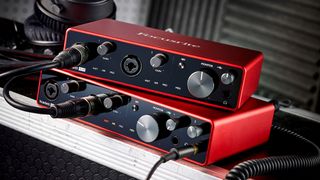
What is an audio interface?
Think of an audio interface as a middle man between your music and your computer. Your interface takes your musical inputs and converts them into 1s and 0s that your computer can understand, a process that happen via the analogue to digital (ADC) converter in your interface.
Once these signals are in your computer and have been manipulated - usually in a DAW - your audio interface will then convert these 1s and 0s back into a waveform, enabling playback through your studio monitors or headphones. This process is takes place via a Digital to Audio converter (DAC).
Who are audio interfaces for?
The best audio interfaces are for anyone who wants to record audio. Whether that's electric guitars, EDM tracks, podcasts, or just get the audio from your latest streaming episode. There are plenty of use cases for those who would need an audio interface, which we've reflected in the product choices for this guide.
Do audio interfaces improve sound quality?
If you think that a new audio interface will improve the quality of your recordings, then we'll be straight with you - this isn't true. At the consumer level, the vast majority of audio interfaces offer very similar recording quality. The difference is in the signal going into your interface. This is why studios use outboard gear like preamps, EQs, and compressors to juice the signal before it goes into the DAW.
In short - what you do to the signal before it goes to the interface and once it's in your DAW is far more important than the actual interface you use.
If you're looking at an interface versus the built-in soundcard in your computer, then yes they do improve the sound quality. An audio interface is much better at converting analogue sounds to digital and vice versa, as well as unlocking the ability to use condenser microphones with phantom power and the built-in preamps.
What are the different types of audio interface?
Most interfaces do a pretty similar job. The only major differentiating factor you'll need to consider is the way they connect. Some use USB, Thunderbolt, Firewire, or PCIe to connect to your laptop or computer. The majority of interfaces offer USB connectivity, but it's always worth double checking to make sure your computer has the right port. We explore the differences between Thunderbolt and USB audio interfaces in this article.
What is an acceptable latency for an audio interface?
Most musician's will say none at all! However this isn't possible when converting audio to digital, so we have to put up with some latency when recording. For us, anything below 20ms is excellent, and the majority of musicians won't notice this amount of latency no matter what instrument their playing.
One exception is vocals, where even tiny amounts of latency can be really off putting. This is because the vocalist will be hearing the sound in their head before the slightly delayed vocal through their headphones. A good recording vocalist will be able to deal with this, but you may have to disable plugins to get the latency low enough for a less experienced vocalist.
How much does an audio interface cost?
It all depends on how much you're willing to spend. For example, the Behringer UMC22 costs around $70, whereas the quad version of the Universal Audio Apollo Twin X will set you back around $1,500. There's also a much more expensive tier for pro studio use that goes into tens of thousands of dollars.
At the consumer level, the actual difference in sound quality isn't that huge. A more expensive interface might have a lower noise floor and better dynamic range, but it's extra features and functionality that you'll be paying for rather than pure sound quality.
What are the popular brands of audio interface?
There are lots of audio interfaces available nowadays, but popular brands for us include Audient, Arturia, Behringer, Focusrite, IK Multimedia, Motu, Native Instruments, PreSonus, Rode, SSL, and Universal Audio.
Should I use forums and user reviews for my research?
User reviews and forums can be a great source of information. However, there is a caveat here as you never know who you're talking to online, whether they actually know what they're talking about, or whether they even own the product. Some retailers feature 'verified' user reviews to show the person has actually bought the product, but many don't which means you can get conflicting or potentially completely incorrect information.
Forums like Reddit are a great source of information if you're looking for a solution to a problem, but you can't always trust the information is correct. There's a well-known Reddit phenomenon known as 'hivemind', whereby one opinion that seems popular gets heavily upvoted despite it being completely wrong. The psychology behind it is that people look at an opinion, see that it's heavily upvoted, and then presume the information must be correct so they too upvote. This can happen the other way too, with perfectly legitimate information getting pushed to the bottom of the page because it gets downvoted a few times by those who disagree.
Bots are also a problem on forums and social media platforms. They look and act like regular users, but are in fact programs designed to respond to comments with a canned response. These can be abused to shift the balance of conversation in a particular way, post links to low-quality websites, as well as spamming posts to send unwanted information to the bottom of the pile. With the advent of AI in the last couple of years, bots have become even more powerful, as they are ever more convincingly able to imitate human behaviour.
We'd always advise doing as much research as possible when buying a new product, but just always be sure to bear in mind where that information is coming from. With MusicRadar, you know that your review is written by an actual musician, with a lot of experience in their particular field.
Shopping advice
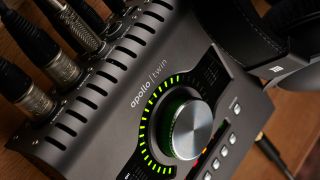
There's a huge number of the best audio interfaces vying for your cash these days, so how do you know how to go about buying yours? We've put together some simple steps for you that will ensure you get the very best interface for your personal use case.
1. Choose your interface - arguably the hardest and longest step, you'll need to decide first and foremost which interface you want. We've sorted the interfaces in this guide via use case, which should give you a good head start. That said you may find multiple interfaces cover your needs, so you may want to start making a shortlist.
2. Read reviews - once you have your selected interfaces, your next step is to read reviews on them. We have reviews for all of the audio interfaces in this guide which can help you make a more informed decision. You may also wish to read reviews on forums or the product pages of retailers' websites but just be advised these aren't likely to be truly impartial.
3. Compare your interfaces - If reviews haven't narrowed down your choices enough, you'll want to compare the interfaces to one another, with your particular use case at the forefront. Many articles do direct comparisons, like our Focusrite Scarlett 2i2 vs Focusrite Scarlett Solo article, but if you can't find something similar for your interfaces, then looking at the specs can be useful. Alternatively, you could list the pros and cons of each can help determine a winner.
4. Choose your retailer - Now that you've got all the information on your chosen interface, it's time to go shopping! You might have a favourite retailer you use, but we'd always advise shopping around for the best price. You might want to use the Google shopping feature, which you can sort by lowest price, or just use the built-in filters on most retailer websites.
5. Wait for a sale - If you're not in a rush, it's totally worth waiting for a sale before you purchase to get a discount on your interface. The biggest sale of the year typically happens around Black Friday, but you'll find retailers offering discounts at various times. This could be a spring or summer sale, Memorial Day or Presidents' Day sale, or just a flash sale on a particular weekend.
Meet the experts

Matt has been recording bands since the mid-noughties, cutting his teeth with an M-Audio M-Track 2 and a copy of Cubase on Windows XP. Since then he's used countless audio interfaces to record music for bands across the UK, covering everything from djent to jazz. As a MusicRadar writer, Matt has reviewed eight audio interfaces in the past year alone, and prior to becoming a writer, spent five years in the music retail industry, providing expert advice to musicians.

Andy is an expert on music production and technology having started out writing for Music Technology magazine in 1992. He has been an editor for Future Music, Keyboard Review, MusicTech, and Computer Music, which he helped launch in 1998. He regularly reviews gear for MusicRadar, ranging from the best audio interfaces and synthesizers to pro studio hardware and software.

Si takes care of the reviews on MusicRadar and Future Music magazine, although you may have also spotted him on camera conducting gear reviews for the MusicRadar YouTube channel. As well as making sure our writing team have the latest gear for review, he's been regularly testing instruments and accessories for well over 15 years, putting audio interfaces, studio headphones, synthesizers, laptops, and much more through their paces.
Read more:
MusicRadar's got your back
- Our pick of the best laptops for music production
- Explore the best budget studio monitors
- These are the best PCs for music production
- Organise your recording space with the best studio desks
